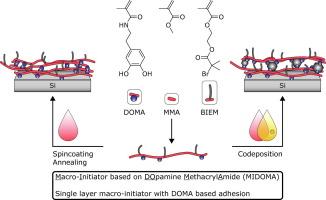当前位置:
X-MOL 学术
›
Appl. Surf. Sci.
›
论文详情
Our official English website, www.x-mol.net, welcomes your
feedback! (Note: you will need to create a separate account there.)
Codeposition strategies for improved layer stability in bio-inspired catechol-containing adhesives
Applied Surface Science ( IF 6.3 ) Pub Date : 2024-11-19 , DOI: 10.1016/j.apsusc.2024.161838 Roland Milatz, Joost Duvigneau, G.Julius Vancso
Applied Surface Science ( IF 6.3 ) Pub Date : 2024-11-19 , DOI: 10.1016/j.apsusc.2024.161838 Roland Milatz, Joost Duvigneau, G.Julius Vancso

|
Catechol-containing copolymers are a class of polymers often encompassing polydopamine and are considered as biomimetic candidates for high-performance adhesives. However, improvements in adhesive layer stability are needed for high-performance applications to enhance the cohesive strength of the adhesive layers. In this paper, we address this challenge by introducing multiple strategies, including thermal treatment and codeposition. We synthesize a copolymer with adhesive dopamine methacrylamide (DOMA), segmental “filler” methyl methacrylate (MMA), and ATRP-initiator 2-(2-bromoisobutyryloxy)ethyl methacrylate (BIEM). This copolymer is spin coated on silicon wafers, annealed at increasing temperatures, and deposited in combination with (3-aminopropyl)triethoxysilane (APTES), iron chloride (FeCl3), or copper chloride (CuCl2) on silicon and polyethylene substrates. The layers are characterized using ellipsometry, atomic force microscopy (AFM), and Fourier transform infrared (FTIR) spectroscopy. Subsequently, we demonstrate the grafting of a zwitterionic polysulfobetaine methacrylate (PSBMA) layer from the BIEM moiety of the codeposited films. Annealing at 200 °C crosslinks the polymer so that almost no physisorbed material remains to be washed off, resulting in enhanced layer stability. Reinforcement through co-deposition shows that using APTES and FeCl3 improved the copolymer layer to graft PSBMA layers from the surface, something that copolymer films cannot exhibit without codeposition. Thus, we demonstrate two pathways based on lessons learned from mussel-based adhesion that can be used to improve PDA-based film formation.
中文翻译:

提高生物启发式邻苯二酚胶粘剂层稳定性的共沉积策略
含邻苯二酚的共聚物是一类通常包含聚多巴胺的聚合物,被认为是高性能胶粘剂的仿生候选物。然而,高性能应用需要提高胶粘剂层的稳定性,以提高胶粘剂层的内聚强度。在本文中,我们通过引入多种策略来应对这一挑战,包括热处理和代码沉积。我们用粘合剂多巴胺甲基丙烯酰胺 (DOMA)、分段“填料”甲基丙烯酸甲酯 (MMA) 和 ATRP 引发剂 2-(2-溴异丁酰氧基)甲基丙烯酸乙酯 (BIEM) 合成了共聚物。这种共聚物在硅晶片上旋涂,在升高的温度下退火,并与(3-氨丙基)三乙氧基硅烷 (APTES)、氯化铁 (FeCl3) 或氯化铜 (CuCl2) 一起沉积在硅和聚乙烯衬底上。使用椭圆偏振法、原子力显微镜 (AFM) 和傅里叶变换红外 (FTIR) 光谱对这些层进行表征。随后,我们展示了从共沉积薄膜的 BIEM 部分接枝两性离子聚磺基甜菜碱甲基丙烯酸酯 (PSBMA) 层。在 200 °C 下退火可使聚合物交联,因此几乎没有物理吸附材料需要洗掉,从而提高了层稳定性。通过共沉积进行增强表明,使用 APTES 和 FeCl3 改进了共聚物层,以从表面接枝 PSBMA 层,这是共聚物薄膜在没有编码沉积的情况下无法表现出的。因此,我们根据从基于贻贝的粘附中吸取的经验教训,展示了两种可用于改善基于 PDA 的薄膜形成的途径。
更新日期:2024-11-19
中文翻译:

提高生物启发式邻苯二酚胶粘剂层稳定性的共沉积策略
含邻苯二酚的共聚物是一类通常包含聚多巴胺的聚合物,被认为是高性能胶粘剂的仿生候选物。然而,高性能应用需要提高胶粘剂层的稳定性,以提高胶粘剂层的内聚强度。在本文中,我们通过引入多种策略来应对这一挑战,包括热处理和代码沉积。我们用粘合剂多巴胺甲基丙烯酰胺 (DOMA)、分段“填料”甲基丙烯酸甲酯 (MMA) 和 ATRP 引发剂 2-(2-溴异丁酰氧基)甲基丙烯酸乙酯 (BIEM) 合成了共聚物。这种共聚物在硅晶片上旋涂,在升高的温度下退火,并与(3-氨丙基)三乙氧基硅烷 (APTES)、氯化铁 (FeCl3) 或氯化铜 (CuCl2) 一起沉积在硅和聚乙烯衬底上。使用椭圆偏振法、原子力显微镜 (AFM) 和傅里叶变换红外 (FTIR) 光谱对这些层进行表征。随后,我们展示了从共沉积薄膜的 BIEM 部分接枝两性离子聚磺基甜菜碱甲基丙烯酸酯 (PSBMA) 层。在 200 °C 下退火可使聚合物交联,因此几乎没有物理吸附材料需要洗掉,从而提高了层稳定性。通过共沉积进行增强表明,使用 APTES 和 FeCl3 改进了共聚物层,以从表面接枝 PSBMA 层,这是共聚物薄膜在没有编码沉积的情况下无法表现出的。因此,我们根据从基于贻贝的粘附中吸取的经验教训,展示了两种可用于改善基于 PDA 的薄膜形成的途径。


















































 京公网安备 11010802027423号
京公网安备 11010802027423号